Marketing automation promises real gains, but sorting lasting trends from hype is a challenge for every marketer I know.
I've seen teams invest in flashy tools only to watch adoption stall and ROI disappoint. It’s tough to know which innovations will actually deliver measurable results, especially when vendors push bold claims without independent proof.
In this article, I’ll break down how to spot genuine automation trends using analyst reviews, cross-sector adoption, and hard performance data. You’ll get practical frameworks for validating new platforms, comparing costs, and avoiding common pitfalls—plus benchmarks from brands like L’Oréal, Sephora, and Zapier.
I’ll also cover AI-powered personalisation, predictive analytics, omnichannel workflows, and how to choose the right automation model for your business. By the end, you’ll have clear checklists and action plans to help your team invest wisely and stay ahead of the curve.
Distinguishing True Marketing Automation Trends from Hype
Spotting Actionable Signals of Genuine Trends
With marketing automation evolving quickly, how do you separate lasting innovations from buzz?
Look for adoption by industry leaders. If platforms like HubSpot, Salesforce, or Marketo unveil a new feature and it achieves 20% user adoption within two years—plus citations from major analysts (Gartner, Forrester, IDC)—that’s a reliable pointer.
But you need more. Focus on measurable outcomes: engagement rising 10–40%, conversions up 5–20%, or costs dropping 12–35%. HubSpot’s AI rollout, for instance, saw 32% adoption, driving double-digit performance gains in 2023.
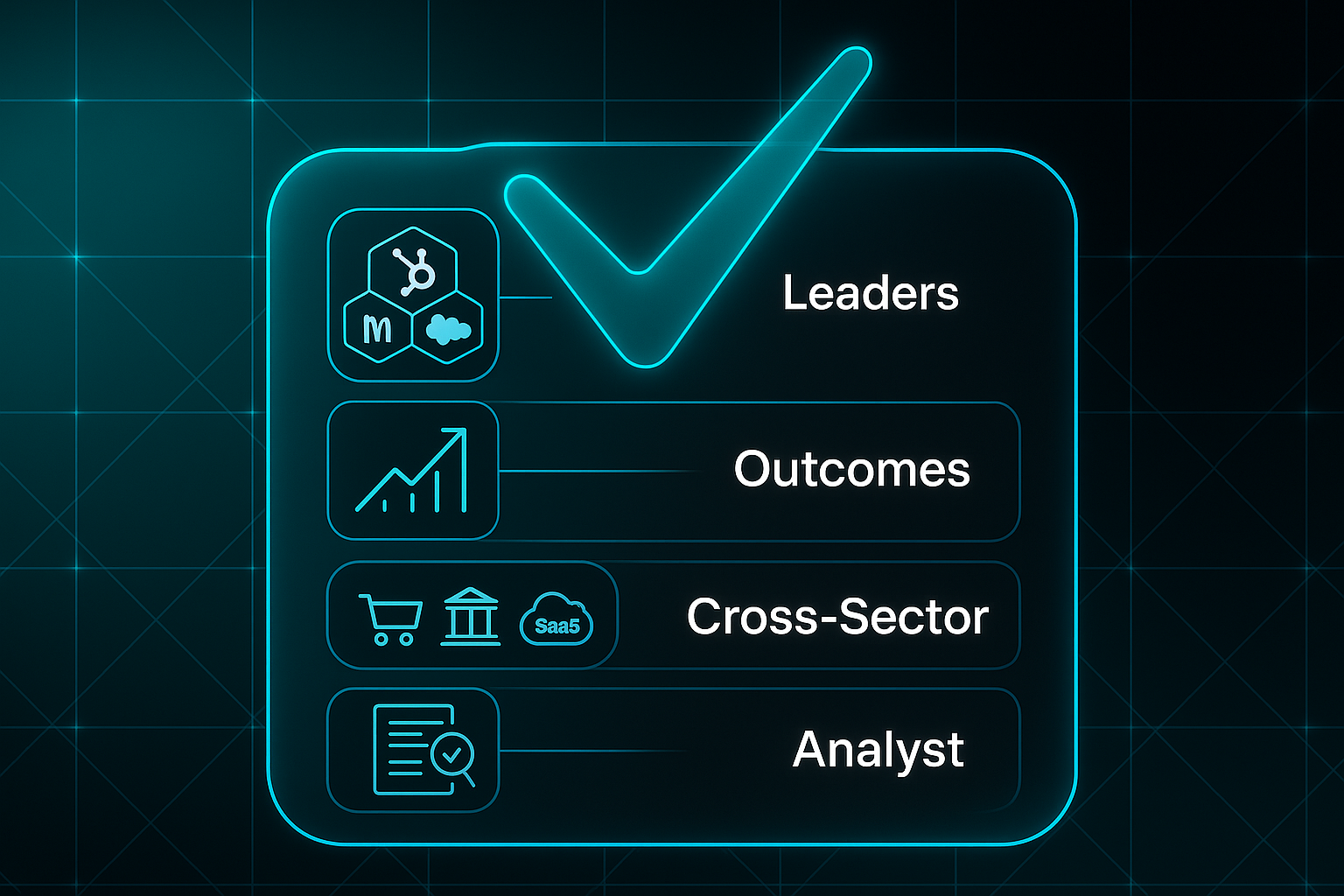
Another clue? Cross-sector recurrence. If the trend pops up beyond SaaS—in retail, DTC, or finance—and keeps showing up in annual CMO surveys, it’s a sign the change is foundational.
In the direct-to-consumer (DTC) sector, leading brands and agencies are now primarily leveraging data and automation to fuel their return on investment.
Be sceptical of vendor claims unsupported by independent reviews. Retail chatbots were hyped as “transformative”, but usage fell 23% due to negative customer feedback, showing why proof matters.
Foundational improvements include AI personalisation (Salesforce, Marketo, Adobe Experience Cloud) and omnichannel automation, confirmed by broad, multi-industry adoption.
Weighing Impact and Costs Behind Adopting a Trend
Spotted a promising trend? Now, assess the investment.
- HubSpot advanced
£700–£2,300/month - Salesforce Pardot
£1,250–£3,600/month - Marketo
£1,400/month (scales by contacts)
Migration/initial setup runs £10,000–£50,000. Staff retraining costs £1,000–£5,000 per person, with ongoing spend reaching 25% of yearly marketing budgets.
Small businesses pay less upfront, but adaptation still strains resources. Enterprises face bigger customisation and switching costs.
Take Adobe: clients using predictive analytics saw 17% churn reduction and 12% ROI uplift in six months.
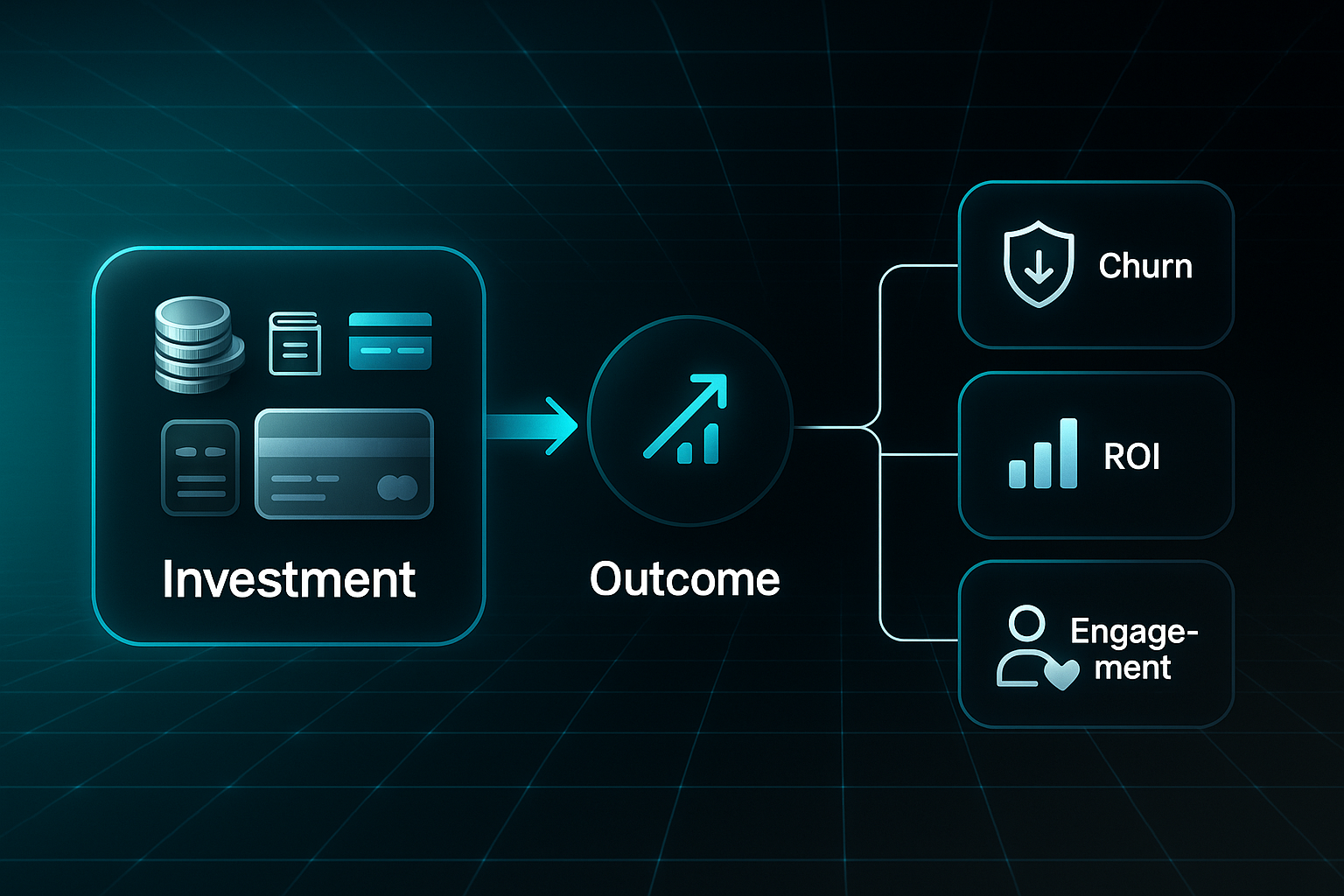
Fast Framework for Trend Validation
For disciplined assessment, use this checklist:
- Confirm analyst credibility.
- Watch leading brand adoption.
- Review three or more independent case studies.
- Ensure GDPR/CCPA compliance and audit data flows.
- Test maturity, interoperability—pilot before scaling.
- Measure conversion, engagement, cost (not vanity metrics).
- Demand consensus from analysts and peer organisations.
Common Pitfalls—and How to Dodge Them
Chasing buzz? Insist on third-party evidence. Integration and compliance missteps stall progress, so bring IT into the loop early and map data flows.
Never depend just on vendor benchmarks. Remember the chatbot fallout—skipping pilot tests led to customer frustration and plummeting usage.
Safety Nets, Prerequisites, and Edge Cases
Pilot new programmes and audit compliance before large rollouts. Maintain backup manual processes, budget for retraining, and use phased experimentation—especially in slower sectors.
A methodical approach helps you spot true trends and sidestep expensive mistakes.
AI-powered personalisation: The rise of hyper-targeted marketing
Comparing AI Personalisation Platforms: Picking the Right Fit for Your Business
Choosing an AI-powered personalisation platform? Business size, sector, and technical capacity all come into play.
If you’re a large, complex brand, platforms like Salesforce and Adobe Experience Cloud are designed to deliver deep CRM integration and multi-channel campaign orchestration. But they aren’t quick to set up—expect onboarding to span 3–6 months.
For single-brand SMBs after speed and simplicity, HubSpot keeps things streamlined. Implementation often wraps up in less than two months. And for brands focused on mobile, Braze leads with real-time triggers and advanced mobile engagement.
Curious about costs and the essentials? Here’s a quick 2024 snapshot:
- Salesforce
£1,250–£3,600/month, with annual minimums. - Adobe Experience Cloud
£1,400+/month; costs scale as you grow. - HubSpot
£700–£2,300/month; easy for SMB budgets. - Braze
Bespoke pricing, user-based minimums.
Integration can be tricky. Salesforce and Adobe need custom API support, while HubSpot is plug-and-play and barely needs IT. Braze requires mobile SDK integration.
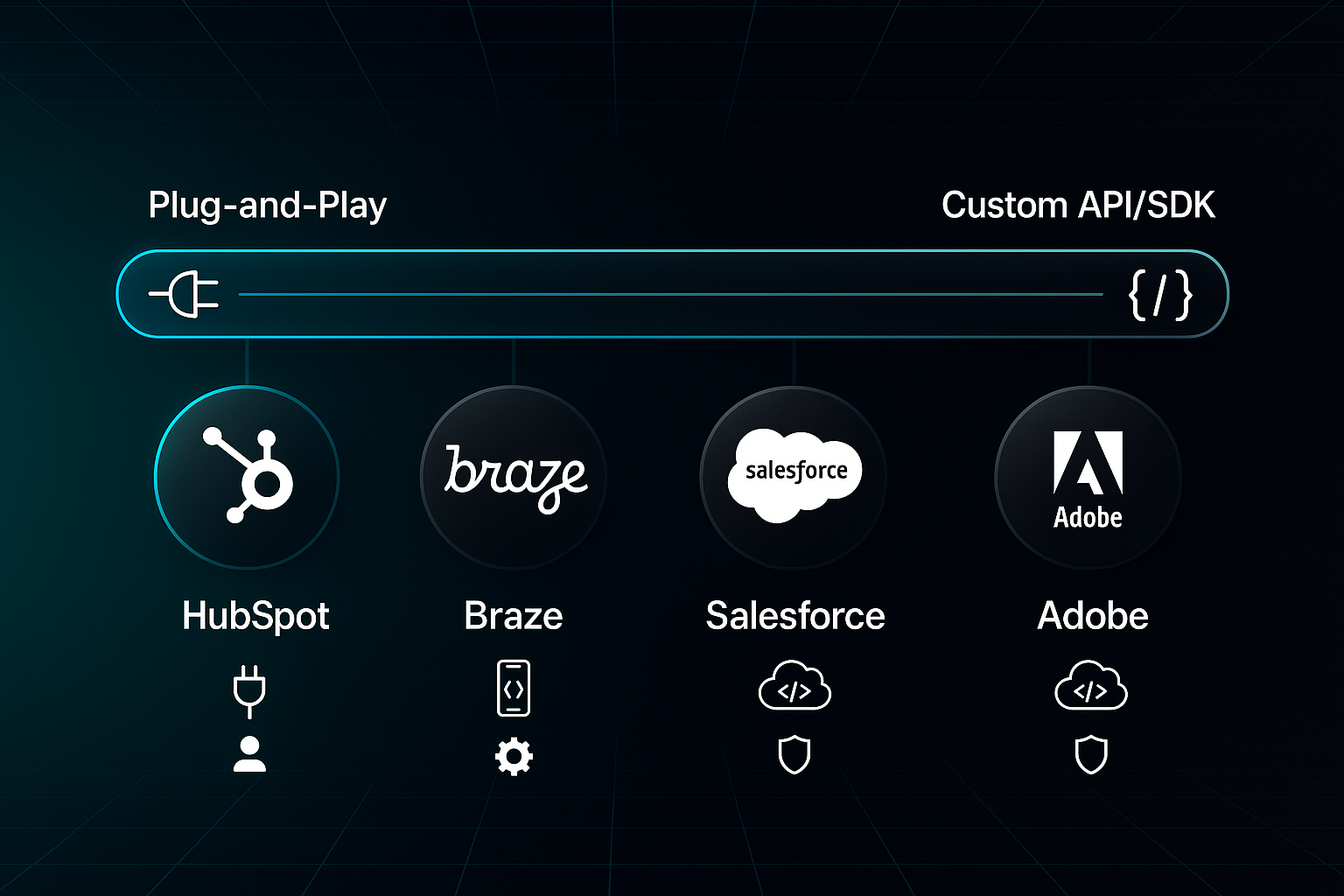
Check the highlights:
- Salesforce Einstein
Predictive analytics, broad campaign control. - Adobe Experience Cloud
Real-time segmentation, GDPR compliance. - HubSpot
Fast launch, SMB-friendly. - Braze
Advanced mobile triggers.
No platform’s perfect. HubSpot can struggle with complex retail, and Braze isn’t built for slow B2B cycles.
Hybrid options like SEOSwarm blend managed agency oversight with scalable AI content automation—ideal for those after quality outcomes without the heavy lift.

AI-Powered
SEO Content Strategy
See the AI platform that's replacing entire content teams (with better results).


Real-World Outcomes: What Do Businesses See?
So, what results can you expect from AI personalisation?
- Salesforce (L’Oréal)
Engagement up 31% in 6 months. - Adobe (Sephora)
Launch in under 3 weeks, retention up 17%. - HubSpot (Zapier)
Go-live in under 60 days, conversion up 14–20%. - Braze (Burger King)
Mobile retention +21%, app engagement +13–19%.
Typically, across platforms: expect 7–35% engagement growth, 8–20% conversion lifts, 9–22% better retention, and campaigns launched in 2–8 weeks. Results rely on clean CRM data, fast onboarding, and a skilled team.

Implementation and Validation: Workflow for Success
Ready to personalise? Follow this rollout:
- Inventory and clean your data, set privacy flags, validate with dashboard checks.
- Set up and train the AI, load past data, and test pilot logic.
- Run pilot campaigns—A/B/n test with 1,000+ users per group.
- Monitor KPIs weekly on dashboards (Adobe Target, Braze Canvas).
- Retrain models quarterly, always reviewing compliance.
Avoiding Pitfalls and Building Safety Nets
Mistakes can happen, but you can prepare:
- Rushed onboarding
Restart pilot, stagger launch, retrain staff. - Over-personalisation
Limit segmentation, track opt-outs. - Low-quality data
Flag errors, use fallback segments. - Validation errors
Pause campaign, trigger rollback. - Platform support lapses
Escalate to expert partners quickly.
Core Checklist: Resources, Budget & Requirements
To deliver on personalisation, here’s what you need:
- Team
Data analyst, marketing ops, compliance lead. - Budget
£10k–£50k onboarding; £700–£3,600/month. - Timeline
4–8 weeks (SMB), 3–6 months (enterprise). - Prerequisites
Unified CRM, consent tracking, full analytics. - Go/no-go
Validate organisation fit, data quality, team skills, and compliance readiness.
Want to transform personalisation from idea to ROI? Walk this path, and you’ll avoid the hype while reaping real gains.
Predictive analytics: Forecasting customer behaviour and campaign outcomes
Choosing the Right Predictive Analytics Platform for Your Organisation
Thinking about predictive analytics for marketing? The first thing to consider is team size, campaign complexity, and the strength of your historical data. You’ll want at least 10,000 clean lead records and ideally a full year’s data for reliable modelling.
Choosing the right platform hinges on matching analytics depth to your needs:
Marketo Engage costs £1,000+/month and takes 4–8 weeks to set up. It suits larger brands needing advanced dashboards, AI lead scoring, and multi-touch attribution. Downsides? Its interface is dated and there’s no free tier.
Oracle Eloqua, at £2,000–£4,000+/month and 4–10 weeks implementation, excels at CRM integration and deep analytics. It’s best for global teams with strong technical skills.
Salesforce Einstein is £1,500–£4,500/month, with 2–6 weeks setup. If you’re already using Salesforce and want robust analytics, it fits the bill—though deployment can be tricky.
ActiveCampaign runs from £49–£259/month, typically needs 1–2 weeks setup for SMBs or startups, and offers basic tools with a rapid launch.
The essentials? Make sure your platform aligns with team skills and integration needs. Prerequisites include a unified CRM, API access, analytics support, and a £25k–£100k onboarding budget.
Deployment, Resources and Pre-launch Checklist
Plan 12–20 onboarding hours for each marketing or data team member. You’ll need a cross-functional squad: data engineer, analytics lead, marketing manager, IT/security—four to six roles.
Integration may run £25k–£100k, plus 20–40% for advanced features and £7.5k–£30k per year for retraining. Aim for 12–24 months of clean CRM and behaviour data, mapped workflows, and API documentation. If your data history is limited, start small and collect as you go.
Quantified Impact: Benchmarks and Real-World Results
What’s in it for your organisation?
- Engagement
15–40% gain in 6–12 months - Conversion
20–50% uplift - Pipeline
20% annual boost (B2B)
A few real-world stats: Siemens (Oracle Eloqua) cut lead qualification by 42%. BlueWave (Marketo Engage) lifted conversions 31%. ActiveCampaign trimmed churn 18%. Salesforce Einstein drove a 27% conversion jump for FinTech firms with two years’ data and 14,000 leads. Target misclassification rates under 7–10%.
Stepwise Implementation and Validation
Your rollout should cover these steps:
- Audit and clean your data for consistency.
- Integrate APIs between CRM, analytics, and marketing tools; check real-time syncing.
- Pilot campaigns using rule-based and AI scoring—keep misclassification below 10%.
- Retrain models monthly and track performance benchmarks.
- Monitor KPIs—rollback if performance drops.
Troubleshooting and Safety Nets
If syncs fail or models drift, run monthly manual reviews and revert to rule-based scoring. If errors exceed 10% for two cycles, retrain or revert fully. Always keep audit logs and review issues as a group.
What to Expect: Resources, Timeline, Results
You’ll need 4–6 hours a month for tuning and a quarterly retraining budget. SMBs can deploy in 1–3 weeks; larger organisations may take 1–3 months. With sound prep, expect 15–40% engagement gains, 20–50% conversion jumps, and pipeline growth within a year. If progress stalls, pause for an audit before deciding to scale.
Deployment of AI-driven Marketing Automation Workflows
Step 1: Platform Selection—Which Tool is Best for Your Needs?
Picking an AI-driven marketing automation platform can feel overwhelming—where do you start?
Begin with your company’s size and sector. HubSpot and Braze suit mid-market or retail brands needing rapid launches and easy dashboards, especially if IT resources are slim. They offer templates and simple integrations.
Go bigger, and you’ll look at platforms like Salesforce Marketing Cloud or Oracle Eloqua. These deliver deeper CRM links, sophisticated bot logic, and custom automation journeys. Braze stands out for mobile-first brands thanks to its real-time triggers.
It’s not just about features and price. Watch for platform lock-in and data portability. Do their templates play well with your martech stack? Can you export your workflows later? And if compliance matters—especially for global operations—look for robust support.
Step 2: Implementation Roadmap—Building and Testing Your Flows
Ready to launch? Start with pilot segments of 1,000–2,000 users, mixing your core market with edge cases.
Import your data, map journey flows, and configure triggers and scoring logic. Use sandbox tools to automate campaign testing before going live. True validation means monitoring “live” logic and anomalies on dashboards like Adobe Target, Braze Canvas, or HubSpot Workflow Analytics.
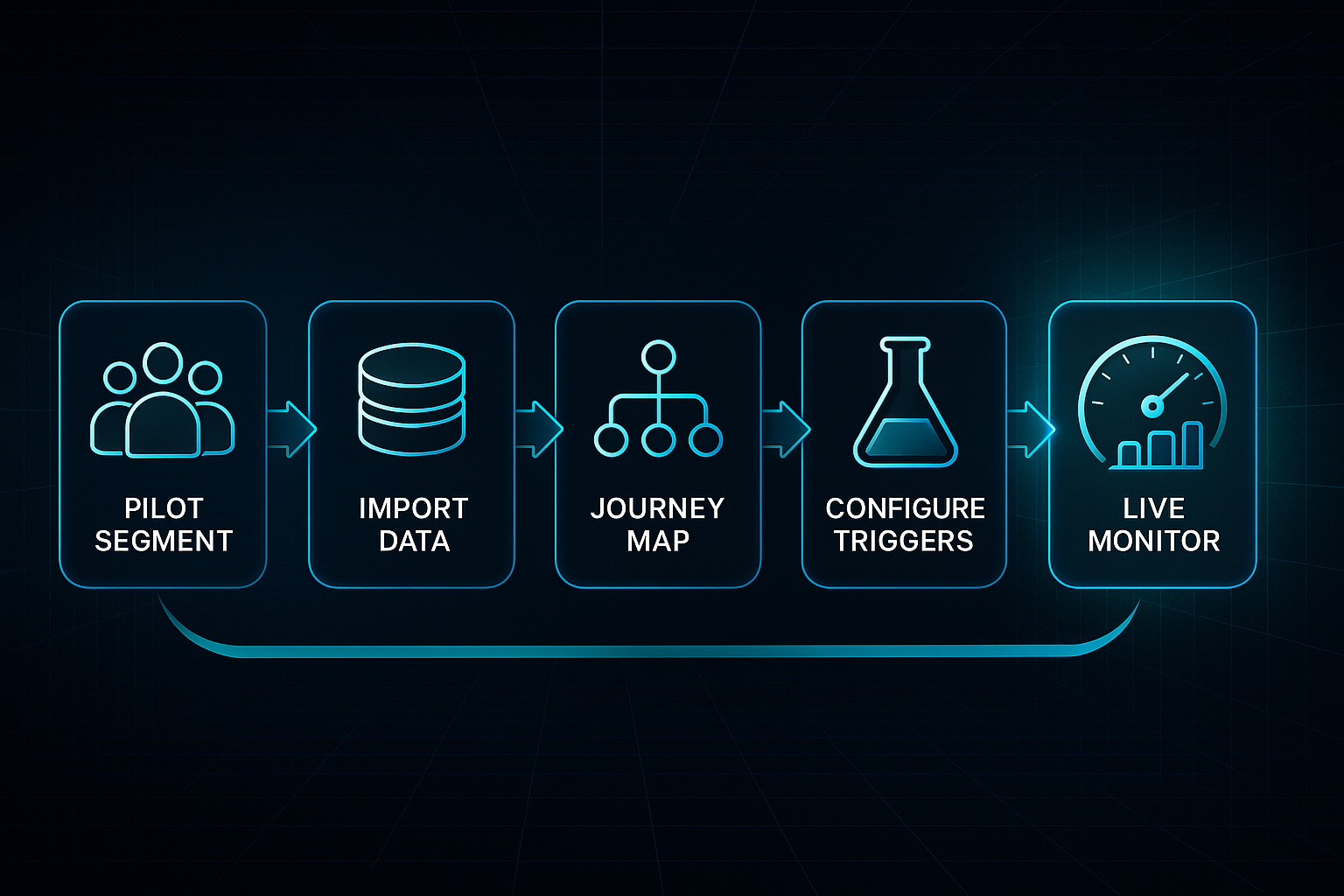
Continuous improvements are vital. Assign responsibility—often the marketing ops lead—for regular flow reviews, aiming for monthly updates.
Step 3: Troubleshooting and Recovery
Expect errors—bots might misfire, scoring can stall. Keep thorough audit logs and real-time error alerts.
If a major failure hits, roll back changes, notify affected users, and log the event in analytics. Always test rollback procedures before your initial deployment; it keeps your responses sharp.
Step 4: Monitoring, Maintenance, and ROI
Track KPIs—conversion rates, engagement, retention—with positive ROI typically seen within 6–12 weeks for SMBs, or 3–6 months for enterprises.
Resource needs shouldn’t be overlooked. Account for multilingual adaptations and schedule quarterly compliance audits. Monthly retraining based on user logs helps expand intent recognition and keep triggers current.
So, for effective orchestration, focus on platform comparison, implementation speed, and resource effort—not just features. That’s how you make marketing automation pay off over time.
Omnichannel and Data-Driven Automation: Creating Seamless Customer Journeys
Selecting the Right Omnichannel Automation Platform for Your Business Needs
When it comes to choosing an omnichannel automation platform, you’ll want one that fits your business size, channels, staffing levels, and compliance needs.
For UK SMBs, Klaviyo is the quick-starter: free for 250 contacts, with paid plans from £24/month. It’s rapid for eCommerce, though support for broader channels is limited.
Segment appeals to businesses needing extensive integrations—over 400 available—starting at £80–£160/month. Getting set up takes 2–6 weeks, and you’ll need some moderate technical skills. Larger clients may pay above £1,000/month.
Enterprises gravitate to Iterable at about £410/month (3–8 weeks’ setup) or Tealium (AudienceStream entry £800/month, enterprise £2,500/month) with deployment fees ranging between £10,000–£50,000 over 4–12 weeks. Those higher prices bring deeper compliance features and more technical involvement for tackling multi-channel complexity.
Expect to budget between £5,000–£45,000 for rollout, with monthly maintenance costs from £500 to £5,000. Ahead of launch, assemble your data team, gather API documentation, and set up robust consent management.
Integration, Validation, and Performance Benchmarks
Your first step is mapping sample data, aiming for less than 1% error. Activate GDPR/CCPA compliance tools, maintaining zero consent data loss.
Pilot campaigns should see data losses below 5%, attribution match above 95%, and complete consent records. Real-time monitoring helps spot problems immediately—set alerts to flag anything out of bounds.
Typical SMB deployment runs 2–6 weeks; enterprises take 4–12. You’ll need 20–80 hours for initial integration, then 4–12 hours monthly for validation and maintenance. Never skip quarterly audits to ensure compliance holds steady.
Troubleshooting, Recovery, and Continuous Compliance
If issues crop up, roll back to your last backup and restore data streams—document everything. Ongoing issues should be escalated to platform support; Segment and Tealium offer premium SLAs from £500/month.
Stick to quarterly privacy audits and keep automated schema validation running. For edge cases like API throttling or consent sync failures, manual override and rollback procedures are your safety net.
Resource and Readiness Checklist for Omnichannel Rollout
Before going live, make sure these are covered:
- Team
Data ops lead (8–12 hrs/week), technical analyst (4–8 hrs/week), marketing/compliance specialist (2–5 hrs/week) - Budget
£5,000–£25,000 setup (SMB), £35,000–£60,000 enterprise; £500–£5,000/month maintenance - Tools
Platform access, tested APIs, automated consent and monitoring - Backup
Disaster recovery/rollback protocol validated - Audit trail
Documented onboarding, mapping, compliance
Cutting corners hikes up the risk of data loss, botched campaigns, or regulatory fines. Better safe than sorry.
Choosing the Right Marketing Automation Model: Platforms, Agencies, and Hybrid Solutions
Map Your Organisational Needs and Constraints
So, how do you pick the marketing automation model that’s actually right for your organisation? The very first step is to dig into your needs and limits.
Start by mapping out your team’s skills—maybe with a simple role-and-skill grid. Who covers tech ops? Who’s your analytics guru? Is there someone who can own content?
Next, take a hard look at staff time. If you can't carve out more than 10 hours a week for marketing ops from each team member, that limits your options quickly.
Set your urgency. Do you need campaigns live in under two weeks? Or can you afford a slower, more hands-on rollout?
And don’t just think about campaigns. Lay out precise goals—how many launches a month, which integrations you need, what numbers you want to beat.
Budget matters too. Decide how much you’re willing to spend upfront (vs ongoing).
Head-to-Head Comparison: Self-Serve, Agency, and Hybrid
Once you know your requirements, run a direct comparison across the three main models.
Self-Serve SaaS (think HubSpot, Marketo, ActiveCampaign) costs £700–£2,300 monthly, with minimal upfront fees. Expect to spend 10+ hours a week managing it, and you’ll need intermediate-to-advanced skills. You get more autonomy and fast updates, but the error risk is higher and scaling tends to be slower. Onboarding ranges from 2–12 weeks.
Fully Managed Agencies such as SmartBug or DemandGen start at £2,000–£10,000 per month. You’ll do less—it’s low client effort—but hand off control of strategy and execution. That buys you faster launch times and strategic backing, though at the cost of higher spending and less platform control. Typical onboarding: 1–3 weeks.
Hybrid Models, including agency + SaaS like SEOSwarm, are £1,500–£5,000 monthly. Both you and the agency share resources, fast launches are possible (as quick as 1–2 weeks), and skills grow on both sides. Scaling’s easier, but pricing gets complicated.
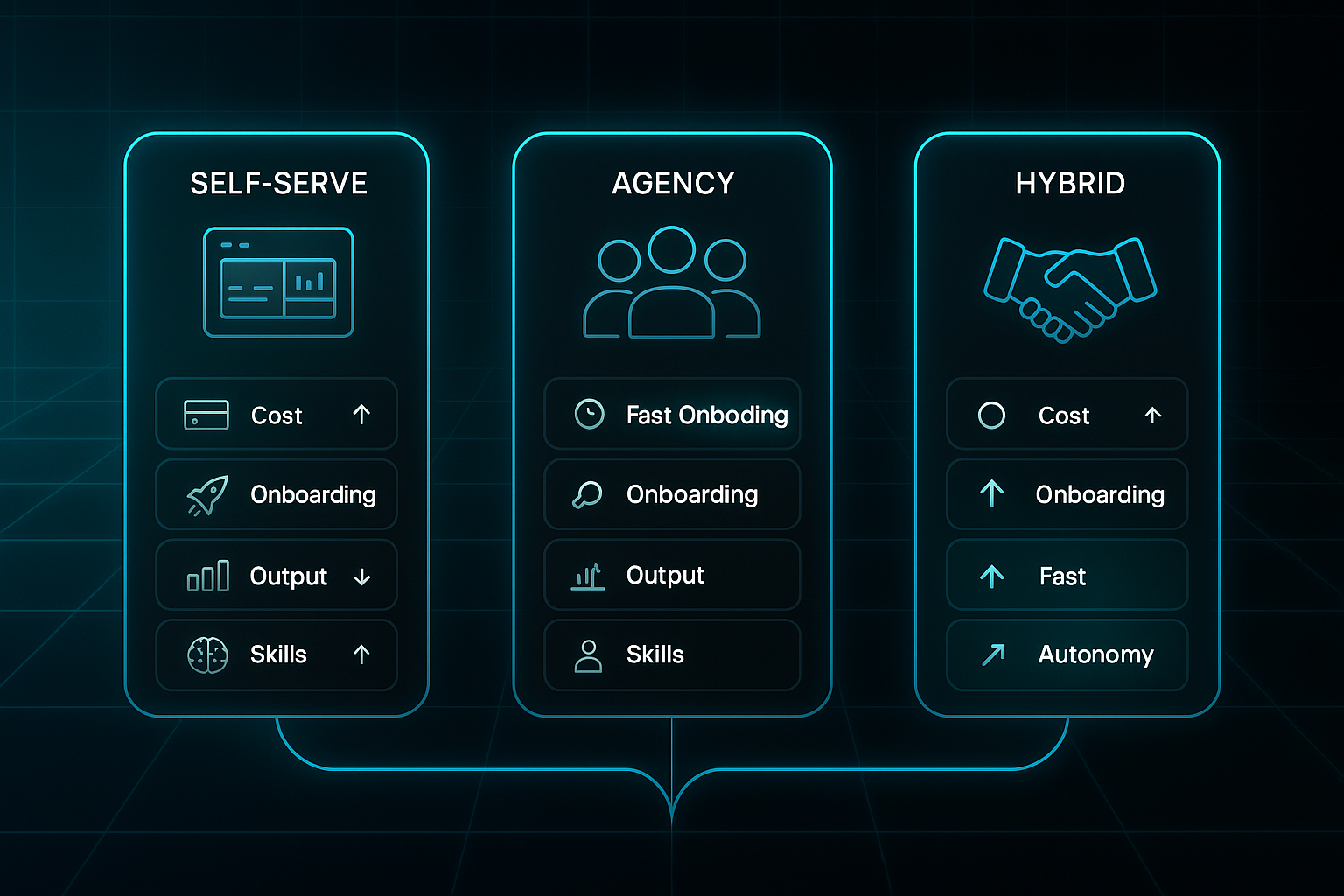
Onboarding takes 1–6 weeks.
Metrics, Benchmarks, and Expected Results
Let’s talk outcomes. With self-serve, onboarding takes 4–12 weeks; agency/hybrid cuts that down by up to 60%. Self-serve means 2–6 campaigns live per month, but agency or hybrid can launch 7–12.
Hybrid and agency-backed launches pull ahead—engagement is often 35–50% better, and scaling can be up to 50% faster. Costs? Over 24 months, self-serve runs £24k–£106k, agency from £82k–£457k+, hybrid somewhere in the middle with scaling advantages. DIY training needs 1–3 months; agency/hybrid is closer to 1–2 weeks.
Use-Case Scenarios: Which Model Suits You?
DIY/self-serve fits tech-enabled SMBs with stable teams and time to build skills.
Agency works best for startups or enterprises facing heavy campaign loads and short deadlines.
Hybrid strikes a balance for fast-growing mid-market companies or teams after more flexibility.
As a hybrid option, SEOSwarm delivers managed SEO launches in 1–2 weeks, scales 25–50% faster, and leverages AI automation for workflow and support. This directly impacts response times and backlogs.

Risks, Mitigation, and Safety Nets
Common issues include skill mismatches, poor handoff, and botched implementations. Map skills up front, plan training or handover, and always document processes to mitigate these problems.
If things fail, stagger onboarding and include fallback clauses so you can revert easily. Fight vendor lock-in with open APIs and verified migration strategies.
Set escalation triggers and preserve admin/data access—if engagement sags or delays drag, you can pivot quickly.
Decision Checklist and Resource Validation
Before you choose, inventory your skills, capacity (hours per week), and budget. Pick your model, negotiate for access and knowledge transfer, and record fallback paths.
Audit onboarding speed, campaign output, and performance against 30/90/180-day KPIs.
DIY demands a marketing ops lead and technical support plus 1–3 months training. Agency/hybrid needs less oversight and a speedy ramp-up.
DIY usually costs £24k–£100k yearly, agency/hybrid £50k–£200k+, but delivers faster ROI.
Validate progress and platform fit with quarterly reviews—tracking throughput, engagement, retention, team input, and flexibility.
That way, you’ll steer clear of missteps and set yourself up for real, measurable impact.
Your Competitors Are Using AI. Are You?
We help companies transition into the new age of marketing.

Overcoming Challenges in Adopting Marketing Automation Trends
Identifying and Resolving Integration Failures in Automation Projects
Integration is often where things get tricky—25% of automation projects stall here. Watch out for API mapping errors that reveal themselves as failed syncs or duplicate data, spotted in logs or flagged by schema validation tools. Data losses above 10% on dashboards mean urgent action is needed.
Set automated alerts for sync failures exceeding 24 hours or error rates over 1% for SMBs and 0.5% per million rows for enterprise. Postman, MuleSoft, or your platform’s monitoring will help, but you’ll need team members with dedicated oversight.
Recovery starts with staged API testing before launch. Roll back to backups if issues arise, keep a regular backup schedule, and stick fiercely to escalation protocols. Never skip logging changes and incidents in tools like Confluence or Notion.
Preventing and Correcting Data Overload and Skill Gaps
Overwhelming data causes more than 40% of failed AI projects. Avoid trouble by using dashboards to catch errors and by assigning staff according to business size.
Choose platforms that provide thorough onboarding and 24/7 support. Regular annual training, clear upskilling benchmarks, and timely retraining are essential. If errors persist for two weeks, KPIs slip by 10–20%, or staff use advanced tools without certification, suspend access and retrain rapidly. Track resource allocation and escalation fees—compare needs for SMBs versus enterprise so you’re ready.
Measuring, Benchmarking, and Recovering from ROI Shortfalls
Before automation launches, record baseline metrics like cost-per-lead and campaign speed. Aim for a 18–40% conversion lift over six months, with faster campaign launches. If you see conversion drops above 10% or enduring delays, investigate and act—revert to manual systems if needed, audit KPIs, or get external support. Keep incident logs for all problems and learnings.
Quick-Reference Escalation Matrix and Edge Case Management
Set clear triggers: API error rates above 1% should mobilise your team; any data delay over 30 minutes goes to IT or vendors. Three unresolved errors in a week merit executive or vendor war room involvement. Uncertified automation tool use? Suspend and accelerate further training. Track staff hours and escalation costs for accurate oversight.
Action Plan Checklist for Automation Challenge Management
Daily and weekly checks on integration, data, and training catch problems before they escalate. Cap troubleshooting budgets, schedule regular retraining, and keep backup plans current.
Document every incident and resolution—this ongoing log keeps your future automation on track and robust.
Opportunities and the Future Outlook for Marketing Automation
Spotting Genuine Innovation Signals for 2025–2027
What real changes in marketing automation should you watch? Three big developments are on the horizon: generative AI agents that optimise campaigns in real time, platforms embedding privacy compliance, and autonomous orchestration streamlining multi-channel flows.
HubSpot, Salesforce Marketing Cloud, Iterable, and Tealium are leading this charge. If you’re curious about measurable gains, early adopters using AI assistants in HubSpot and Salesforce have seen 30–50% engagement increases. Tealium’s AudienceStream automates compliance, delivering a 60% workload reduction. Iterable users report a 23% conversion lift and campaigns running 38% faster. Forrester forecasts over 40% of medium-to-large enterprises adopting these features by 2026.
In 2025, enterprise AI adoption is at an inflection point: what began as cautious pilots has become a race to scale generative AI for measurable impact across entire organizations.
The Shifting Talent Landscape for Automation
All this innovation means marketing teams need hybrid, specialist skills—think data scientists, automation leads, and compliance pros. LinkedIn reports UK postings for “automation ops” and “AI marketing analyst” jumped 31% this year. Current best practice? Aim for 1–2 new certifications annually per staff member on platforms like HubSpot or Salesforce.
Agencies have adapted, offering flexible support so brands can scale quickly during intense campaign cycles. Analyst surveys show 67% of top teams will have at least two certified automation specialists, and 88% of agency-backed groups are adding technical and compliance roles.
Staying Ahead: Your Future-Ready Plan
To keep pace, schedule quarterly reviews for platform updates and regulatory changes. Dedicate 10% of team hours to learning, demos, and experimenting with workflows. Every six months, reassess platforms and partners for strengths or gaps. Pilot new features with benchmarks—engagement uplift or compliance improvement—and document results to guide future scaling.
Best-Practice Checklist for Futureproofing Automation
- Monitor
Track tech, upgrades, and laws quarterly. - Validate
Review skills, relevance, and compliance quarterly. - Pilot
Test new tools with limited segments. - Adopt
Scale up after proven pilots and audits. - Document
Log changes and outcomes for sustainable growth.
My Take on Marketing Automation Trends That Matter
Most marketing automation trends sound promising, but only a handful deliver real, measurable impact. I’ve seen too many teams chase hype, only to hit integration snags, budget overruns, or disappointing results. The difference lies in disciplined validation—adoption by leaders, analyst consensus, and proven outcomes.
Here’s my advice: Before investing, run a checklist—confirm independent evidence, pilot with real users, and monitor conversion, engagement, and compliance. Map your team’s skills, budget, and urgency, then choose the model that fits—self-serve, agency, or hybrid. Document every step, and schedule quarterly reviews to keep your automation evolving and your team learning.
Marketing automation isn’t a one-time fix—it’s a continuous process of testing, refining, and scaling. The teams that thrive are those who treat automation as a living system, not a static tool. The future belongs to marketers who measure, adapt, and never stop improving.
- Wil

